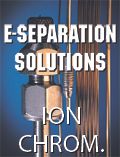Ion Chromatography
Joining us for a discussion on ion chromatography this month are experts from Dionex, Metrohm and Merck.

Ion chromatography continues to expand from a specialized technique into a mainstream chromatographic technique, and our experts discuss this trend in this month’s technology forum roundtable.
Joining us for a discussion on ion chromatography this month are Jason Wood of Dionex Corporation; Markus Läubli of Metrohm; and Dr. Tobias Jonsson, Dr. Petrus Hemström, and Dr. Wen Jiang of Merck SeQuant AB.
What current trends do you see emerging in ion chromatography?
Wood:Current trends appear to focus on several key areas: 1) growth intraditional markets, such as water testing, that have new regulationsthat require lower detection limits; 2) expansion into new areas such asthe growth of IC-MS with high-end IC and high-end MS instrumentation,i.e., for haloacetic acids. A new market that is developing wellis metabolomics research where ion chromatography is able to separateions that normally appear in the void volume of RP-HPLC; and, 3) fasteranalysis times and lower detection limits are becoming more importantfor most markets as well as easier-to-use instrumentation with turn-keysolutions.
Läubli: The predominant requirement involves a higher sample throughput with improved detection limits and reduced personnel costs. For however complicated the sample matrix is — gaseous, solid, or a highly contaminated waste water sample — with the appropriate automated inline sample preparation technique and detector even ultra-traces can be accurately determined in a short time.
Merck Group: Ion chromatography and HPLC are merging and the reason is the development of universal detectors like mass spectrometry, evaporative light scattering, and charged aerosol that do not rely on chromophores in the molecules for detection. A separation technique that matches this development very well is hydrophilic interaction chromatography, or HILIC in short. As confirmed by several surveys this is by far the fastest growing HPLC technique for separation of small molecules, including anions, cations, zwitterions, and neutral polar compounds. In other words, all types of compounds that C18 columns have trouble to retain and separate. Here metabolites of all kinds are heavily represented. The strength of HILIC lies in its ability to separate all these types of compounds on the same column, in the same run, and on the same HPLC instrumentation that the chromatographer is used to for reversed phase separations. The rapid development in ionization techniques for MS has not led to less demand on the separation power, but rather to higher demands to enable quantification without ion suppression.
Has ion chromatography expanded or shrunk in recent years, in terms of application growth and use across the industry?
Wood:Ion chromatography has continued to grow and expand in recent yearswith new applications in all markets including the Bio IC andpharmaceutical, food analysis, power industry, and semiconductor industrymarkets as well as in the traditional water testing and environmentalanalysis. New applications are constantly being developed for allmarkets.
Läubli:IC expanded in all areas.
Merck Group:It has definitively grown. Monitoring of constituents in food and beverages, quality control of renewable sources of fuel, and contaminants in the environment are some of the areas that have grown.
What do you expect or hope to see in the ion chromatography industry in the long term?
Wood:An increase in innovation and an evolution to smaller, turn-key(walk-up) instrumentation. The recent development of a commercialcapillary ion chromatography system has allowed IC systems to rununattended for extended periods of time without the need for dailymaintenance except to add samples. Additionally, new columntechnologies, such as the expansion into monolith columns for IC willbroaden the application base for IC in the years to come with a focus toshorter analysis times or higher chromatographic resolution.
Läubli:Besides a continuous growth, we expect further developments in the column technology and a stronger emphasis on sample preparation.
Merck Group:The trend to do more in less time will naturally continue, but the focus is shifting from separation efficiency, short columns, small particles, and UHPLC, to separation selectivity as the approach to reaching this. The years when chromatographers tried to solve all separation problems with C18 have simply passed. The selectivity trend is exemplified by HILIC on the one hand and the interest in mixed mode separations on the other. The perfect complementary approach of reversed phase and HILIC indicates though that these two modes will solve the majority of the separation problems whereas mixed mode will be limited to specific applications — partly because of the complexity of predicting this type of separation and the high demand this places on the user.
Have you seen any lingering affect from the acetonitrile shortage in ion chromatography? (If yes, please explain).
Wood: The acetonitrile shortage has had almost no affect on the ionchromatography market because the typical eluents used are water basedrather than organic solvents, such as acetonitrile.
Läubli: We experienced only little influences as acetonitrile is used in only a few applications. Acetonitrile is generally added in small amounts as eluent modifier to improve selectivity. In most of the cases, switching to acetone or methanol was a suitable alternative.
Merck Group: There have been some tendencies among very price-sensitive users to continue considering alternative solvents like methanol when doing new method development. On the other end of the spectrum are chromatographers that are very dependent on acetonitrile for performance reasons, and thus have turned to reliable suppliers that even during the acetonotrile shortage crisis never were out of stock.
If you are interested in participating in any upcoming Technology Forums please contact Associate Editor Meg Evans for more information. Next month’s forums will focus on the GC and HPLC/UHPLC markets.








